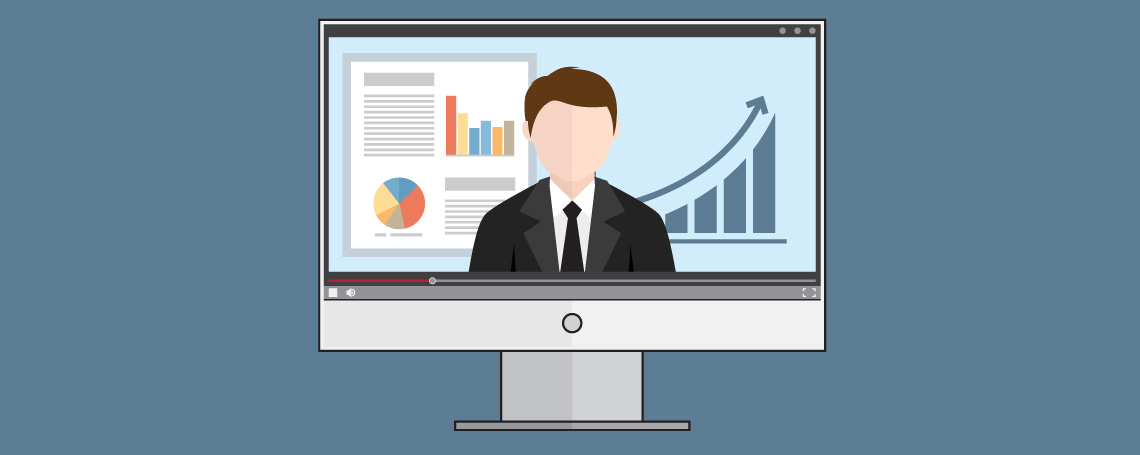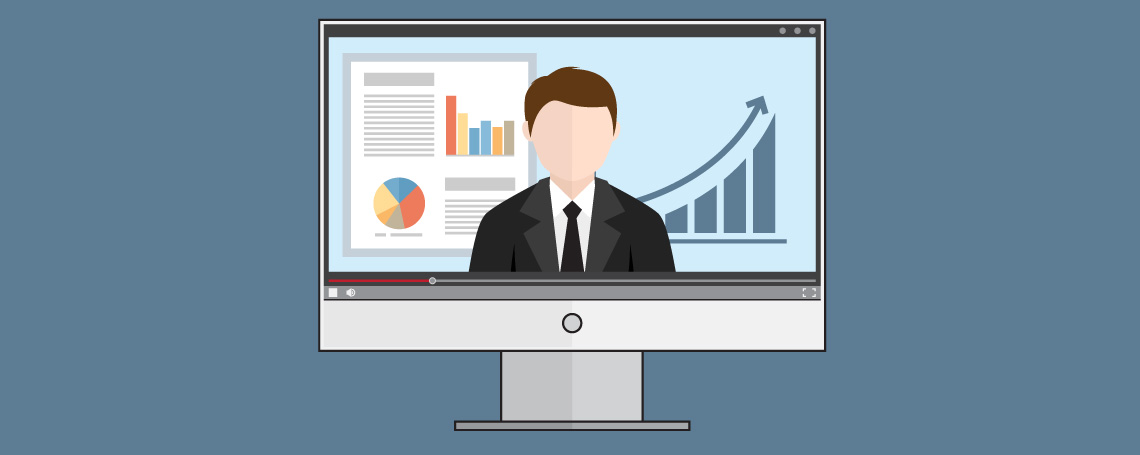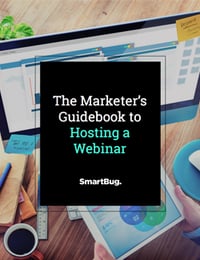
The 5 R’s of How to Create and Launch a Webinar
August 14, 2015

I remember the first time I was really involved in putting a webinar together. My boss was running around like a chicken with its head cut off, stressing about every little detail. (I tried to remain calm.)
It can be a stressful affair. For many companies, a webinar represents the only time they present to a large audience of leads, customers, industry experts, and sometimes, press. And usually, it’s live. So if you screw up, it’s pretty public. “Technical difficulties” (I hate that term) are just the tip of the iceberg in terms of what can go wrong.
 (My most panic-inducing moment was when our in-house expert and webinar presenter was stuck at his house because it had dumped several feet of snow that night and his car couldn’t get down his ridiculously long, snow-filled driveway. [Picture is of just the flat part of his driveway.])
(My most panic-inducing moment was when our in-house expert and webinar presenter was stuck at his house because it had dumped several feet of snow that night and his car couldn’t get down his ridiculously long, snow-filled driveway. [Picture is of just the flat part of his driveway.])
While putting together a webinar may never be as easy as 1-2-3, even getting started on the right path can be daunting if it’s your first webinar. However, a webinar is one of the greatest tools in a marketer’s box for all stages of inbound marketing (attract, convert, close, delight) and, depending on the content, can appeal to people in all stages of the buyer’s journey.
Kicking Off Your First Webinar with 5 R’s
1. Research
After you’ve determined the purpose of your webinar (including target persona and whether your primary goal is to attract, convert, close, or delight), planning should begin at the research level. Some questions to explore:
- What other webinars are popular in your space? (Industry sites, competitors, customers’ presentations, etc.) If you can find out which ones were more successful, this is extremely helpful.
- Depending on your purpose, what should the content focus around? Should it be educational, product-focused, company-focused, etc.? If it’s educational, what specific topics are most relevant to your product and company?
- What would be the best way to present the topic? Via one presenter? Via a panel? Should the speaker(s) be in-house or external? Should the webinar be live or pre-recorded?
- Once you’ve determined a topic, are there existing experts you can contact and ask to present? If you decide to utilize an internal speaker, who has the bandwidth to handle putting together the content?
2. (Get) Ready
Okay, you’ve done some research on topics and speakers and have decided on both. Prior to promoting the webinar, you’ll need to have the following details nailed down:
- Date and length of the webinar. Tuesday-Thursday is usually considered best and make sure you select a time zone that works for your target audience.
- Title, abstract, photo of the speaker, and biography of the speaker. Develop these in conjunction with the speaker, if possible.
- Software to host the webinar. I highly recommend GoToWebinar as I have found it to be the easiest to use and least prone to problems. GoToWebinar registration also integrates with HubSpot.
- If you will have a moderator and who that will be. A moderator introduces the speaker and verbally asks the audience’s typed questions to the speaker at the end of the webinar.
- Questions for the audience. What questions do you want to ask people who register for the webinar? Do you want to have any polls during the webinar? Do you have any questions for them after the webinar is over?
- Promotion plan for getting people to register. Are you going to use email, social media, etc.?
- Registration form in HubSpot or webinar tool. This needs to be live prior to any promotional activities.
- Always have a technology run-through with the speaker and moderator using the software you plan to use. This has saved more headaches than I could possibly count. I also found for internal speakers that a dry run was very helpful.
3. Reach
Now it’s time to reach your audience with your webinar offer! Don’t overlook any of these tactics:
- Email your in-house database. My experience has found that three emails work best: the first email two weeks in advance, the second email one week in advance, and the final email the day prior. Try both HTML and text emails to see which type your audience responds to. Also make sure emails #2 and #3 filter out people who have already registered. (I get so annoyed when I get invites to webinars I’ve already signed up for.)
- Social media. Use social media to promote your event and get new leads interested in you! Try a combination of Facebook ads, posts, and events, LinkedIn ads, posts, and groups, Twitter ads and tweets, Google+ posts, and any niche social media your target audience visits.
- Add it to your website. Depending on the topic, you may want to add CTAs on every page of your website or the home page to gain additional exposure.
- Have all employees add it to their email signature line. It’s free and easy.
- If your speaker is external, have them email their list and post to their social media. Great way to expand your reach.
- If the topic is particularly meaty or you have a really great speaker, put out a press release. You could also just send a note to an industry web publication journalist you already have a relationship with.
4. Roll out
Difference Between a Webinar and Webcast
The terms “webinar” and “webcast” have been used pretty interchangeably to describe presenting a web seminar (“webinar”) or web broadcast (“webcast”). Some people have differentiated the two terms by level of interactivity with the audience, but this distinction is often overlooked. Recently, though, Citrix (a premier provider of online meeting software) defined GoToWebinar as a product for up to 1,000 attendees and GoToWebcast for up to 5,000. We will have to see if this definition takes off.The day has finally arrived and you are ready to go live! This is the really scary part! Here are some tips:
- Have the speaker log in about 15 minutes early to make sure everything is working. Ask him or her to mute their phone (cell and office), put a sign on their door, close out of email and chat, etc.
- Have a designated “tech person” to answer chat questions regarding sound issues, not being able to log-in, will the slides be available, etc.
- Always mute the attendees; otherwise, you’ll end up with awful feedback. Also mute the moderator while they aren’t speaking.
- Make sure to record the webinar and have a “back-up” recording mechanism in case one fails. GoToWebinar has a recording feature built-in, and I have used Camtasia as a fail safe.
- Always have back-up questions in case the audience doesn’t have any questions. There’s nothing worse than sitting there at the end of the webinar to dead silence because there are no questions.
5. Revisit
After the webinar is done, I usually heave a huge sigh of relief (especially if there were no “technical difficulties”). However, you just had a whole bunch of people engage with you for an hour – now’s not the time to drop the ball!
- Define what the next step for attendees will be. Do you want them to download the slides? Is it a phone call with a salesperson? How would it be most appropriate to present this next step – at the end of the webinar? Via email? After they view the recording?
- Send an email to all the attendees with a link to the recording and slides. Think about segmenting out those who weren’t able to attend and customizing their message slightly.
- Set up lead nurturing where applicable. For new leads, would it make sense to drip email them over the next couple of weeks?
- Think about how you can use the webinar content in other ways. Can you upload the slides to SlideShare? How about writing a blog post using the same content? Webinars are a lot of work, so make sure you get the most out of it you can.
- If the webinar topic doesn’t go stale, continue to publish social media posts with a link to the recording. As you have new followers, they might be interested in the content.
Do you have any webinar tips or tricks to share? I’m currently writing an ebook and would love to include any advice you have. Let us know by tweeting us at @smartbugmedia.

About the author
Jessica Vionas-Singer was formerly the Senior Director of Client Success at SmartBug Media where she lead a team of SmartBugs who focus on HubSpot onboarding for clients new to the system and other project-based work, oversaw new employee onboarding, and rolled out new process and procedures within the Client Services department. She fell in love with marketing at her first job at a technology company specializing in credit evaluation software. Her background includes more than 20 years of marketing experience in content creation and lead-driving tactics, online presence and blog creation, social media engagement, budgeting and project plans, webinar and trade show event management, public relations, comprehensive promotional campaigns, and analytics. Jessica has a BS in Sociology from Montana State University – Bozeman. Read more articles by Jessica Vionas-Singer.






